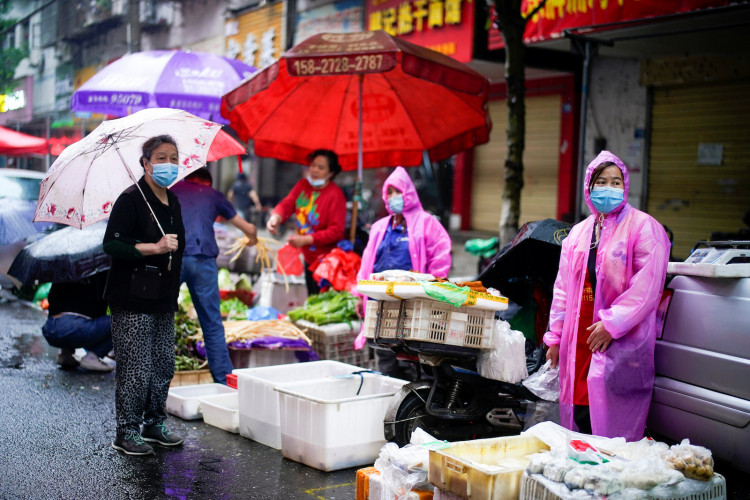A recent study published in the journal Cell provides compelling evidence supporting the theory that the COVID-19 pandemic originated from the Huanan Seafood Market in Wuhan, China, likely through the transmission of the virus from animals to humans. This new analysis strengthens the argument that SARS-CoV-2, the virus that caused the global pandemic, emerged through a spillover event involving animals sold at the market, rather than a lab leak, a theory that has persisted in some circles.
The research, led by an international team of 23 scientists, analyzed genetic material collected from hundreds of swabs taken from various surfaces within the market, including stalls, floors, and drains. The results revealed the presence of DNA from animals known to be susceptible to COVID-19, including raccoon dogs, civets, and bamboo rats. These findings, while not definitively proving that the animals were infected with the virus, suggest that the animals were likely in close proximity to the virus at the time of the pandemic's emergence.
Dr. Kristian Andersen, director of infectious disease genomics at the Scripps Translational Research Institute and a senior author of the study, emphasized the significance of these findings. "The clustering of viral and animal DNA in the same areas of the market strongly suggests that the virus jumped from animals to humans in this environment," Andersen explained. He added that the data indicates the virus likely emerged between mid-November and mid-December 2019.
This study builds on earlier research that proposed an animal spillover as the likely source of the pandemic. Raccoon dogs, in particular, are considered a strong candidate for transmitting the virus to humans, as they have been shown to be susceptible to COVID-19 and capable of spreading the infection. "The presence of raccoon dog DNA near SARS-CoV-2 samples is particularly compelling," said Andersen. "It strongly supports the theory that these animals played a role in the virus's transmission to humans."
The use of metagenomic sequencing, a technique that analyzes all genetic material present in a sample, was crucial to identifying the species in proximity to the virus. This technique allowed researchers to trace the virus's origins with greater precision, providing further circumstantial evidence that the Huanan market was a central site of early viral transmission.
However, while the study provides significant evidence supporting the animal spillover theory, the authors acknowledge that their findings cannot completely rule out other possibilities, including the lab leak hypothesis. "The publicly available genomic and epidemiological data from the start of the COVID-19 pandemic remain incomplete," the study reads, suggesting that future research could provide further clarity.
The lab leak theory, which posits that the virus accidentally escaped from a Wuhan laboratory researching coronaviruses, has been the subject of intense debate and investigation. Dr. Andersen, who initially entertained the possibility of a lab origin, changed his stance after reviewing the accumulating data. "As scientists, we follow where the data leads," Andersen said. "And in this case, all the available evidence points to a natural spillover event, likely from animals to humans in the market."
The findings align with previous studies conducted by Chinese researchers and published in Nature in 2023. These studies also pointed to wildlife trade in the Huanan market as the likely origin of the pandemic. "What this adds is a greater weight of evidence," said Professor Florence Debarre of the French National Centre for Scientific Research, a co-author of the study. "As data keep accumulating, all the results still go in the same direction - an origin linked to wildlife trade in the Huanan market."
The implications of these findings are significant, not only for understanding how COVID-19 emerged but also for preventing future pandemics. Andersen emphasized that while lab safety regulations have been strengthened in the wake of the pandemic, there has been less focus on regulating wildlife trade, which continues to pose serious risks. "The unregulated wildlife trade is a $50 billion annual industry in China alone," Andersen pointed out. "This remains an ongoing threat to global health."
The study also identified another virus, H9N2 flu, in samples taken from the Huanan market, underscoring the broader risks posed by the wildlife trade. Andersen warned that the emergence of other dangerous viruses is only a matter of time if stronger regulations are not put in place. "SARS-CoV-2 wasn't special, necessarily. It was just a virus in the right place at the right time," he said. "The same scenario could be happening now with H5N1 bird flu in other parts of the world."
As debates about the origins of COVID-19 continue, Andersen and his team hope that their findings will guide future pandemic preparedness efforts. "We need to take a hard look at the wildlife trade, which is the bigger threat right now," Andersen said. "It's not enough to focus solely on lab safety. We need to address all the factors that contribute to the risk of pandemics."






